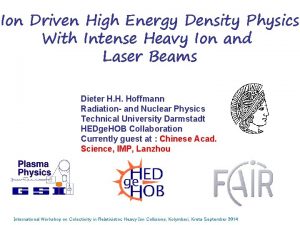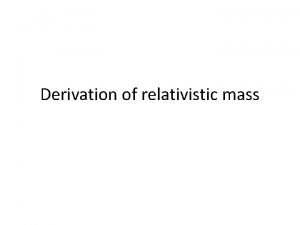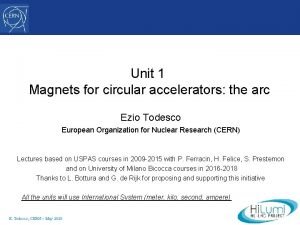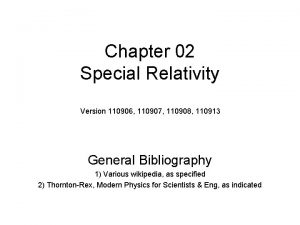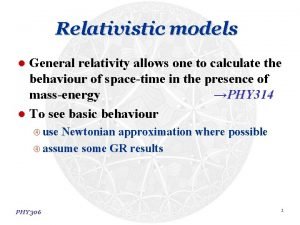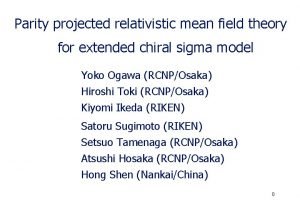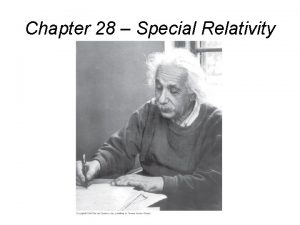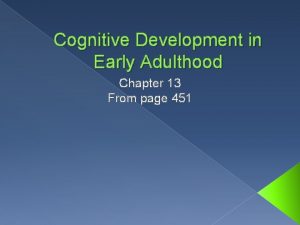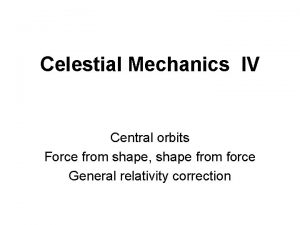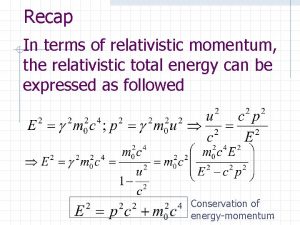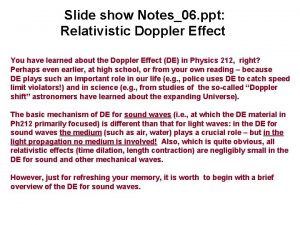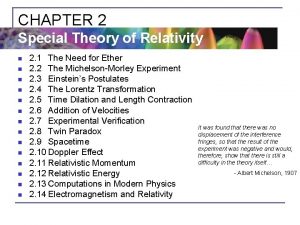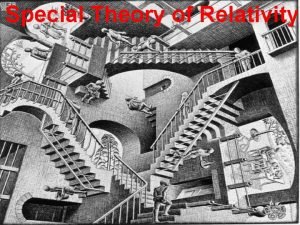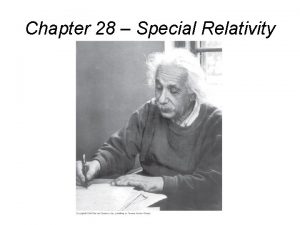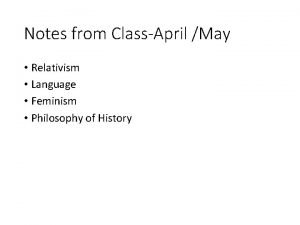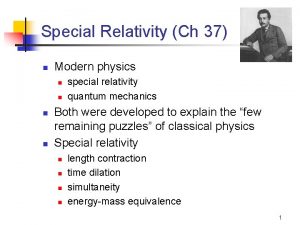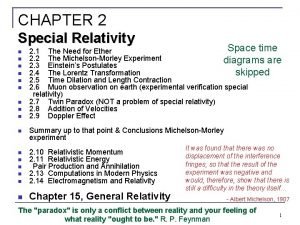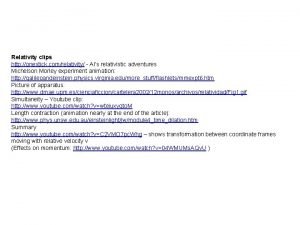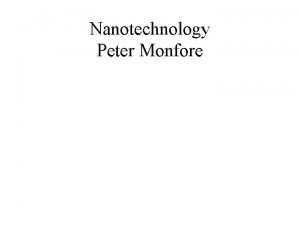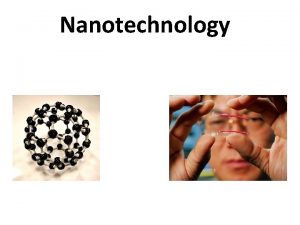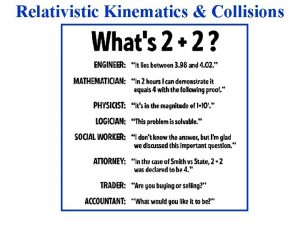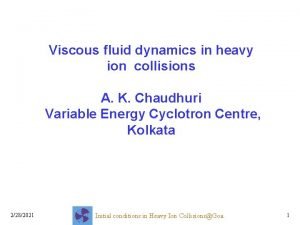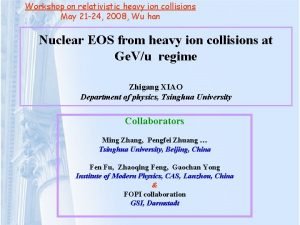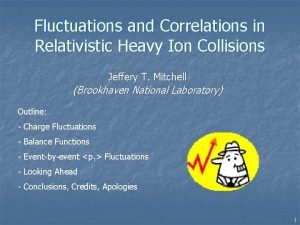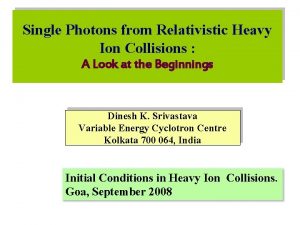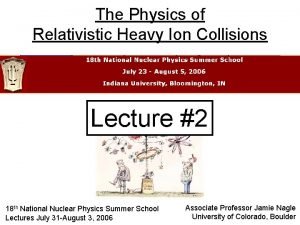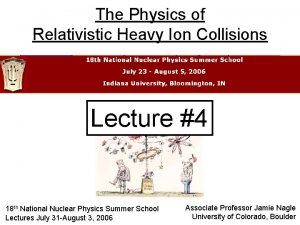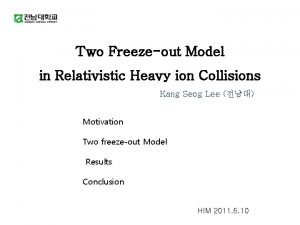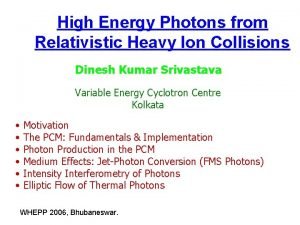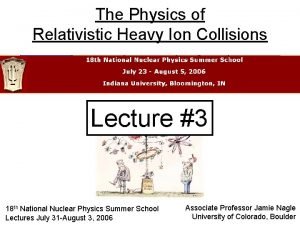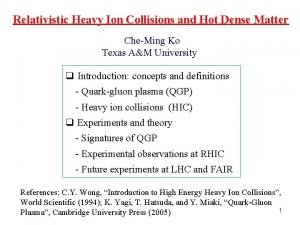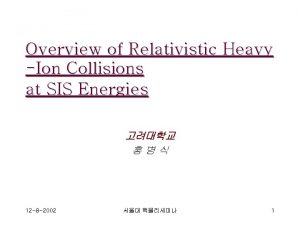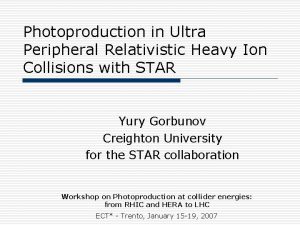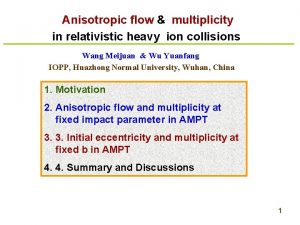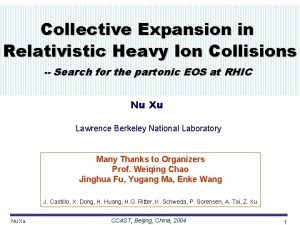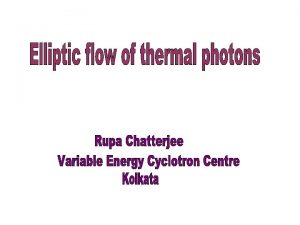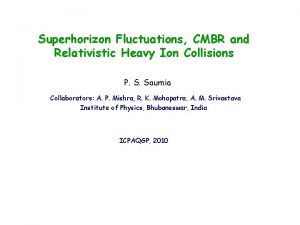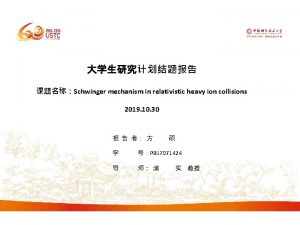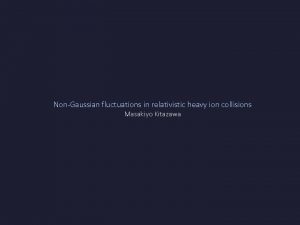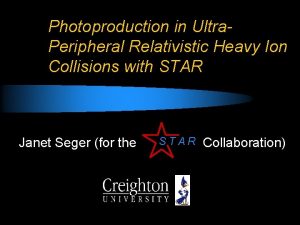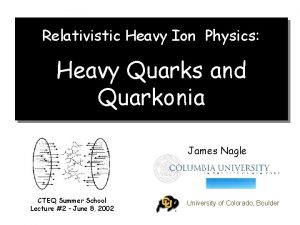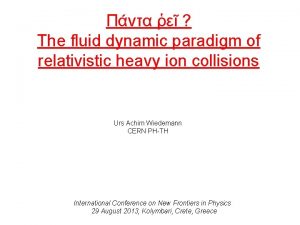Relativistic Fluid Dynamics in Heavy Ion collisions NanoTechnology


![Rayleigh – Taylor Instability High pressure Spherical compression [LLNL] 3 Rayleigh – Taylor Instability High pressure Spherical compression [LLNL] 3](https://slidetodoc.com/presentation_image_h2/68c54b010c0396ef222e630bfc1dbcf6/image-3.jpg)







![[ A. H. Taub (1948) ] Taub assumed that (physically) only slow space-like shocks [ A. H. Taub (1948) ] Taub assumed that (physically) only slow space-like shocks](https://slidetodoc.com/presentation_image_h2/68c54b010c0396ef222e630bfc1dbcf6/image-11.jpg)



![[ R. Chatterjee, et al. , Phys. Rev. Lett. 96, 202302 (2006) ] 15 [ R. Chatterjee, et al. , Phys. Rev. Lett. 96, 202302 (2006) ] 15](https://slidetodoc.com/presentation_image_h2/68c54b010c0396ef222e630bfc1dbcf6/image-15.jpg)

![[ E. Frodemann, et al. , J. Phys. G 34, 2249 -2254 (2007) ] [ E. Frodemann, et al. , J. Phys. G 34, 2249 -2254 (2007) ]](https://slidetodoc.com/presentation_image_h2/68c54b010c0396ef222e630bfc1dbcf6/image-17.jpg)

![[ Stefan Floerchinger, and Urs Achim Wiedemann, Phys. Rev. C 89, 034914 (2014) ] [ Stefan Floerchinger, and Urs Achim Wiedemann, Phys. Rev. C 89, 034914 (2014) ]](https://slidetodoc.com/presentation_image_h2/68c54b010c0396ef222e630bfc1dbcf6/image-19.jpg)







![[ Martin Greve, IFT Seminar, Fall (2017) for PV Solar panels] 27 [ Martin Greve, IFT Seminar, Fall (2017) for PV Solar panels] 27](https://slidetodoc.com/presentation_image_h2/68c54b010c0396ef222e630bfc1dbcf6/image-27.jpg)




- Slides: 31

Relativistic Fluid Dynamics in Heavy Ion collisions, Nano-Technology and Laser driven Pellet Fusion L. P. Csernai - IFT Colloquium, Bergen, Feb. 16, 2018 N. Kroo, Hungaran Acad. Sci. Budapest 1 I. Papp, Babas-Bolyai Univ. , Cluj

Burning of Quark Gluon Plasma in Relativistic, Radiation Dominated Systems according to Relativistic Fluid Dynamics Applications to Pellet Fusion Classical Fluid Dynamics (CFD) does assumes that all dynamical processes, including shocks and detonations, are having speeds which are slower than the speed of light, c. (Note, however: Einstein’s GR: Synchronizing watches) Engineering books keep this assumption even today! In ICF research the mechanical Rayleigh – Taylor instability is the major obstacle to reach ignition in the whole volume of the target fuel. 2
![Rayleigh Taylor Instability High pressure Spherical compression LLNL 3 Rayleigh – Taylor Instability High pressure Spherical compression [LLNL] 3](https://slidetodoc.com/presentation_image_h2/68c54b010c0396ef222e630bfc1dbcf6/image-3.jpg)
Rayleigh – Taylor Instability High pressure Spherical compression [LLNL] 3

The ICF research Lasers at NIF The Au hohlraum at NIF 4

5

Indirectly Driven, ICF target for NIF Time profile of the laser beam: Initial precompression of ~ 10 ns, Stable compression Then 3, 4 “shocks” of 3 -5 ns to ignite [O. A. Hurricane et al. , Nature, 506, 343 (2014), doi: 10. 1038/nature 13008 ] 6

• The hohlraum The reconstructed size & shape of ignited source ( ~ 30 x ) Max. compression Re expansion 7

8

Approximate energy efficiency of diff. process steps of NIF: Energy out … … … 0. 003318% !

Burning of Quark Gluon Plasma in Relativistic, Radiation Dominated Systems according to Relativistic Fluid Dynamics Applications to Pellet Fusion Classical Fluid Dynamics (CFD) does assumes that all dynamical processes, including shocks and detonations, are having speeds slower than the speed of light, c. Initial Relativistic FD (RFD) maintained this assumption based on the requirement of causality [A. Taub, 1948]. Engineering books keep this assumption even today! Relativistic Heavy Ion Physics proved the opposite! 10
![A H Taub 1948 Taub assumed that physically only slow spacelike shocks [ A. H. Taub (1948) ] Taub assumed that (physically) only slow space-like shocks](https://slidetodoc.com/presentation_image_h2/68c54b010c0396ef222e630bfc1dbcf6/image-11.jpg)
[ A. H. Taub (1948) ] Taub assumed that (physically) only slow space-like shocks or discontinuities may occur (with space-like normal, λ 4=0). This was then taken as standard, since then (e. g. LL 1954 -) 11

[ L. P. Csernai, Zh. Eksp. Teor. Fiz. 92, 379 -386 (1987) & Sov. Phys. JETP 65, 216 -220 (1987) ] corrected the work of [ A. Taub, Phys. Rev. 74, 328 (1948) ] 12

[ L. P. Csernai: Introduction to Relativistic Heavy Ion Collisions, (1994, John Wiley & Sons, Cichester, England) ] 13

Discovery of QGP: 2000 CERN 2001 BNL [U. W. Heinz and P. F. Kolb, Phys. Lett. B 542, 216 (2002)] 14
![R Chatterjee et al Phys Rev Lett 96 202302 2006 15 [ R. Chatterjee, et al. , Phys. Rev. Lett. 96, 202302 (2006) ] 15](https://slidetodoc.com/presentation_image_h2/68c54b010c0396ef222e630bfc1dbcf6/image-15.jpg)
[ R. Chatterjee, et al. , Phys. Rev. Lett. 96, 202302 (2006) ] 15

Light cone [ E. Molnar, et al. , J. Phys. G 34 (2007) 1901 ] 16
![E Frodemann et al J Phys G 34 2249 2254 2007 [ E. Frodemann, et al. , J. Phys. G 34, 2249 -2254 (2007) ]](https://slidetodoc.com/presentation_image_h2/68c54b010c0396ef222e630bfc1dbcf6/image-17.jpg)
[ E. Frodemann, et al. , J. Phys. G 34, 2249 -2254 (2007) ] 17

18
![Stefan Floerchinger and Urs Achim Wiedemann Phys Rev C 89 034914 2014 [ Stefan Floerchinger, and Urs Achim Wiedemann, Phys. Rev. C 89, 034914 (2014) ]](https://slidetodoc.com/presentation_image_h2/68c54b010c0396ef222e630bfc1dbcf6/image-19.jpg)
[ Stefan Floerchinger, and Urs Achim Wiedemann, Phys. Rev. C 89, 034914 (2014) ] Light cone 19

Light cone [ N. Armesto, et al. , Nucl. Phys. A 931 (2014) 1163 ] 20

Applications to Pellet Fusion Up to now all theoretical studies of Internal Confinement fusion are based on Classical Fluid Dynamics (CFD). Still the aim is to • achieve Volume Ignition • achieve Rapid Ignition • but within CFD ? ! Relativistic Heavy Ion Physics proves that simultaneous ignition and burning is possible, both theoretically and experimentally! This is not against causality, as the burning front is within the light cone of the initial state (i. e. the initial ST configuration). 21

This is not against causality, as the burning front is within the light cone 22

Fusion reaction: D + T n(14. 1 Me. V) + 4 He (3. 5 Me. V) Constant absorptivity, Spherical irradiation Ignition temperature = T 1 Simultaneous, volume ignition up to 0. 5 R (i. e. 12% of the volume). Not too good, but better than: [ L. P. Csernai & D. D. Strottman, Laser and Particle Beams 33, 279 (2015). ] 23

Can we achieve better volume ignition, and how? Two ideas are combined by L. P. Csernai, N. Kroo, I. Papp [ Patent # P 1700278/3 ](*) • Heat the system uniformly by radiation with RFD • Achieve uniform heating by Nano-Technology Mechanical compression and adiabatic heating should be reduced, because it is slow and leads to Rayleigh-Taylor instabilities. Similarly outside ablator surface should be reduced also. Uniform, 4π radiation should heat the target to ignition within the light penetration time (i. e. ~ 10 -20 ps). This follows from RFD! 24

How can we achieve uniform heating? • Optimize the light absorptivity of the target by imbedding golden nano-shells of resonant size into the DT pellet. • Nano-shells can increase light absorption by up to a factor of 30 or more. - Light heats up 1 st the external surface of the pellet and for a longer time. To compensate for this we have to increase the absorptivity of the central domains of the pellet. - We can optimize the absorptivity by imbedding nanoshells of increasing density towards the center of the pellet. - This way we can achieve near uniform, simultaneous, volume ignition. 25

The reflectivity of the target can be made negligible, and the absorptivity can be increased by one to two orders of magnitude by the plasmonic nano-shells embedded in the target fuel. Thus higher ignition temperature can be achieved with no or modest compression. The short light pulse can heat the target so that most of the interior will reach the ignition temperature simultaneously. This prevents the development of any kind of mechanical or pressure instability, which would prevent complete ignition of the target. 26
![Martin Greve IFT Seminar Fall 2017 for PV Solar panels 27 [ Martin Greve, IFT Seminar, Fall (2017) for PV Solar panels] 27](https://slidetodoc.com/presentation_image_h2/68c54b010c0396ef222e630bfc1dbcf6/image-27.jpg)
[ Martin Greve, IFT Seminar, Fall (2017) for PV Solar panels] 27

Golden Nano-Shells – Resonant Light Absorption 28

T (Me. V) The absorption coefficient is linearly changing with the radius: In the center, r = 0, αK = 30 cm-1 while at the outside edge αK = 8 cm-1. The temperature is measured in units of T 1 = 272 ke. V, and Tn = n T 1. Simultaneous, volume ignition is up to 0. 9 R, so 73% of the fuel target! 29

Another Option to Reach Volume Ignition Heavy-Ion Beams – FAIR & NICA Ø Energy deposition by heavy ion beams – Bragg peak! Ø Absorption depth can be tuned! Ø Beam bunch energy distribution could be achieved Ø Present Bunch length is ~ 70 ns Ø Bunch length of 10 ps may be reached [B. Shakov, p. c. ] Ø Proposal(s), Patent(s) 30

Thus, ultra-relativistic heavy ion physics did not only lead to fundamental discoveries, as the Eo. S and transport properties of Quark Gluon Plasma (QGP), but also to advances in relativistic fluid dynamics (RFD), which may revolutionize the technological development of Inertial Confinement Fusion research and other dynamical radiation dominated processes. * 31
 Top heavy bottom heavy asymptotes
Top heavy bottom heavy asymptotes Heavy ion
Heavy ion Ejemplo de fuerza ion ion
Ejemplo de fuerza ion ion Fuerzas dipolo dipolo ejemplos
Fuerzas dipolo dipolo ejemplos Uniones intermoleculares
Uniones intermoleculares Dispersion forces examples
Dispersion forces examples Reflective and relativistic thinking
Reflective and relativistic thinking Relativistic mass formula
Relativistic mass formula Relativistic circular motion
Relativistic circular motion Relativistic kinetic energy
Relativistic kinetic energy General relativity formula
General relativity formula Relativistic mean field theory
Relativistic mean field theory Relativistic kinetic energy
Relativistic kinetic energy Cognitive changes in early adulthood
Cognitive changes in early adulthood Relativistic thinking example
Relativistic thinking example Relativistic equations of binet
Relativistic equations of binet Relativistic momentum
Relativistic momentum Doppler effect animation ppt
Doppler effect animation ppt Kinetic energy of a relativistic particle
Kinetic energy of a relativistic particle Relativistic mass formula
Relativistic mass formula A physical education chapter 28
A physical education chapter 28 Relativistic thinking example
Relativistic thinking example Relativistic momentum
Relativistic momentum Kinetic energy of a relativistic particle
Kinetic energy of a relativistic particle Bertrand postulate
Bertrand postulate Viscoseal
Viscoseal Ecf icf and interstitial fluid
Ecf icf and interstitial fluid Movement of body fluids
Movement of body fluids P1-p2
P1-p2 Ascitic fluid examination
Ascitic fluid examination Hypoosmotic
Hypoosmotic Fluid statics deals with
Fluid statics deals with

